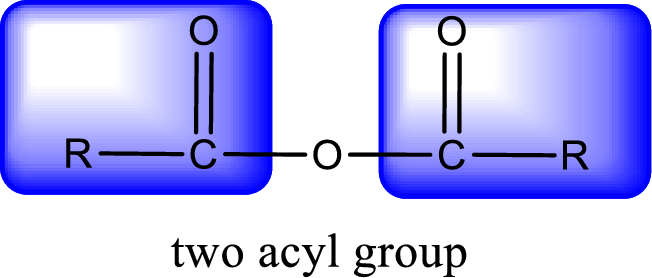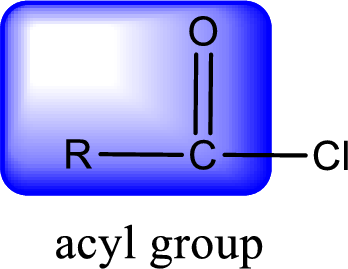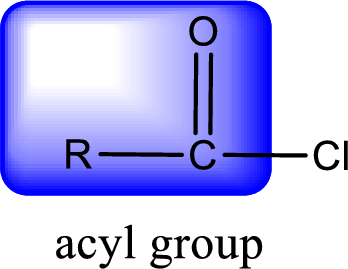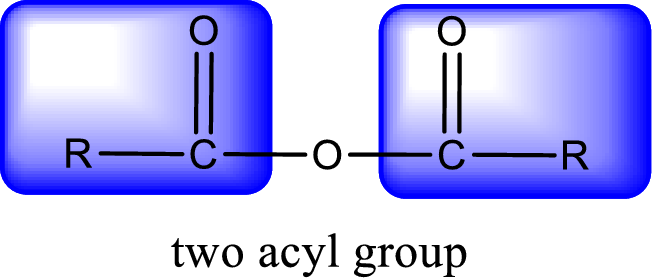
Concept explainers
(a)
Interpretation:
IUPAC name for the given compound has to be assigned.
Concept Introduction:
For naming an acid anhydride, it can be structurally viewed in a way that contains two carbonyl groups that is joined by a single oxygen atom. This can also be said as two acyl group joined by a single oxygen atom.

Rules to obtain IUPAC name and common name for an acid anhydride:
- IUPAC name and common name for Symmetric anhydride is obtained by replacing the acid present in the name of parent
carboxylic acid with the word anhydride. - IUPAC name and common name for mixed anhydride is obtained by using the names of the parent carboxylic acids arranged in alphabetical order that is followed by the word anhydride.
(b)
Interpretation:
IUPAC name for the given compound has to be assigned.
Concept Introduction:
For naming an acid chloride, it can be structurally viewed in a way that contains one acyl group with a chlorine atom bonded to the carbonyl group

Rules to obtain IUPAC name and common name for an acid chloride:
- IUPAC name for acid chloride can be obtained from the parent carboxylic acid name. In the parent carboxylic acid name, the ending “-oic acid” is replaced by “-oyl chloride”.
- Common name for acid chloride can be obtained from the parent carboxylic acid name. In the parent carboxylic acid name, the ending “-ic acid” is replaced by “-yl chloride”.
(c)
Interpretation:
IUPAC name for the given compound has to be assigned.
Concept Introduction:
For naming an acid chloride, it can be structurally viewed in a way that contains one acyl group with a chlorine atom bonded to the carbonyl group

Rules to obtain IUPAC name and common name for an acid chloride:
- IUPAC name for acid chloride can be obtained from the parent carboxylic acid name. In the parent carboxylic acid name, the ending “-oic acid” is replaced by “-oyl chloride”.
- Common name for acid chloride can be obtained from the parent carboxylic acid name. In the parent carboxylic acid name, the ending “-ic acid” is replaced by “-yl chloride”.
(d)
Interpretation:
IUPAC name for the given compound has to be assigned.
Concept Introduction:
For naming an acid anhydride, it can be structurally viewed in a way that contains two carbonyl groups that is joined by a single oxygen atom. This can also be said as two acyl group joined by a single oxygen atom.

Rules to obtain IUPAC name and common name for an acid anhydride:
- IUPAC name and common name for Symmetric anhydride is obtained by replacing the acid present in the name of parent carboxylic acid with the word anhydride.
- IUPAC name and common name for mixed anhydride is obtained by using the names of the parent carboxylic acids arranged in alphabetical order that is followed by the word anhydride.
Want to see the full answer?
Check out a sample textbook solution
Chapter 5 Solutions
EBK ORGANIC AND BIOLOGICAL CHEMISTRY
- presented by Morallen Lig Intermine the hand product for the given mution by adding atoms, bonds, nonhonding diarion panda скуль Step 3: Comp the draw the product Step 2: Agama workup Compithe 429 ملولةarrow_forwardReaction A 0,0arrow_forwardpresented by Morillon Leaning Predict the organic product for the min кусур HSC Adithane carved arnown to come than that to the condon slchroruis in acid in in aquishri with ноюarrow_forward
- 6.15PM Sun Mar 30 K Draw the major product of this reaction. Include any relevant stereochemistry. Ignore inorganic byproducts. Problem 1 of O H [PhзPCH2CH3]*C|¯ NaH Drawing > Q Atoms, Bonds and Draw or tap a nearrow_forward8:17 PM Sun Mar 30 Draw the major product of this reaction. Ignore inorganic byproducts. HSCH2CH2CH2SH, BF3 Probler Drawing Ato Bonds Clarrow_forwardpresented by Mr L How the coprion. (Il Done in no wraction, dew the starting redential) доarrow_forward
- 8:16 PM Sun Mar 30 K Draw the major product of this reaction. Ignore inorganic byproducts. Proble 1. CH3MgBr 2. H3O+ F Drawingarrow_forwardо но оarrow_forwardName the major organic product of the following action of 4-chloro-4-methyl-1-pentanol in neutral pollution 10+ Now the product. The product has a molecular formula f b. In a singly hain, the starting, material again converts into a secule with the molecular kormula CIO. but with comply Draw the major organic structure inhalationarrow_forward
- Macmillan Learning Alcohols can be oxidized by chromic acid derivatives. One such reagent is pyridinium chlorochromate, (C,H,NH*)(CICTO3), commonly known as PCC. Draw the proposed (neutral) intermediate and the organic product in the oxidation of 1-butanol by PCC when carried out in an anhydrous solvent such as CH₂C₁₂. PCC Intermediate OH CH2Cl2 Draw the intermediate. Select Draw Templates More с H Cr о Product Draw the product. Erase Select Draw Templates More H о Erasearrow_forwardIf I have 1-bromopropene, to obtain compound A, I have to add NaOH and another compound. Indicate which compound that would be. A C6H5 CH3arrow_forwardProvide the reagents for the following reactions.arrow_forward
 Organic And Biological ChemistryChemistryISBN:9781305081079Author:STOKER, H. Stephen (howard Stephen)Publisher:Cengage Learning,
Organic And Biological ChemistryChemistryISBN:9781305081079Author:STOKER, H. Stephen (howard Stephen)Publisher:Cengage Learning, General, Organic, and Biological ChemistryChemistryISBN:9781285853918Author:H. Stephen StokerPublisher:Cengage Learning
General, Organic, and Biological ChemistryChemistryISBN:9781285853918Author:H. Stephen StokerPublisher:Cengage Learning


